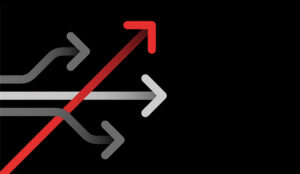Nobody could have predicted the impact that 2020 would have on the way we live and work.
When the pandemic struck, everything we knew about work turned upside down. Suddenly, offices were empty, and people from all backgrounds were working from home.
While remote work drives the way for greater productivity than in-office employment, there are downsides too.
31% of employees say they struggle with mental health and have needed a day off to deal with it while remote working. 29% of remote employees also say they have a hard time managing work-life balance.
A successful strategy for the future of hybrid work means understanding both the short-term effects of Covid-19 on the way we work, and the long-term implications for wellbeing.
The Short-Term Effects: What We’ve Seen So Far
Many companies have experienced the issues of an unexpected shift to remote work first-hand.
Although the idea of more flexible working patterns has been appealing to us for some time, the transition in 2020 happened a lot faster than we expected. Some of the biggest short-term effects we’ve noticed are:
1. Feelings of Isolation and Detachment
Work gives us a sense of shared purpose and a connection with other people. No matter what industry you’re in, a workplace is a community.
However, when team members are on their own at home, they start to feel more isolated. They can lose sight of the company vision and disengage from their workplace. The result is a feeling of detachment and isolation.
Working at home can make it tougher to build relationships with colleagues. There aren’t as many opportunities for random interactions and bonding activities.
That’s why companies moving into the age of remote work need to work so hard to keep teams connected through regular video conversations, voice calls, chats, and shared experiences.
Short-term, the shift to video conferencing en masse was evidence of the isolation that teams felt. Long-term, video demand will continue, though companies will need to be more cautious about the security and feature sets they provide.
2. Lost Focus
Research tells us that the home work environment is perfect for knowledge workers who need a higher level of concentration.
However, not everyone sees a boost to their focus levels when they’re outside of the office. Some employees will benefit from a dedicated home space where they can avoid distractions in the office. Others will have distractions at home too.
Many employees pushed to fully work in a remote landscape didn’t have specific rooms they could shut themselves in, away from the distractions of family members and pets.
Additionally, when we’re stuck at home, it can also be easier to focus on the negative things happening in the world around us. During the early stages of the pandemic, it was easy to get overwhelmed by fears.
Going forward, companies will need to embrace a more hybrid approach to work that supports both kinds of working strategy. Additionally, some brands may begin to offer wellness and mindfulness guidance that can help employees to handle any periods of stress that may be stealing their focus.
3. Anxiety, and Mental Health Issues
The implications of the pandemic on mental health have been astronomical. Most people, no matter their age, background, or gender, have been afflicted with feelings of fear, sadness, worry, or frustration during this difficult time.
Working from home has also made it harder for us to turn to our colleagues and friends for support during these difficult moments.
The influence that the pandemic has had on mental health is likely to last for some time, even after social distancing and restrictions begin to ease. With that in mind, it will be increasingly essential for companies to invest in wellness programmes that put all aspects of health first.
Team members should have a consistent and reliable way to reach out for assistance when they need it. Going forward, we’re likely to see more mental health wellness days and support options being offered by businesses of all backgrounds.
4. Tech Overwhelm
Before the pandemic, most of us were already using a significant amount of technology in our day-to-day lives.
Everything in the business landscape was increasingly data-driven and tech-focused. However, the shift to remote working also meant that many of us were bombarded with new technology faster than ever before.
Out of nowhere, we suddenly had to become accustomed to new scheduling tools, video-conferencing applications, and project management apps that we may not have used at home.
As business leaders looked for ways to ensure that employees would remain productive in any environment, the number of tech tools we used each day increased significantly.
In the long-term, there’s no doubt that we’ll continue to demand technology to help us manage a range of tasks and expectations. However, it will also be important for companies to think carefully about which tools are necessary, to reduce the overwhelm.
Single-pane-of-glass environments for tracking data and productivity will be the way of the future, and every team will have access to training when they need it most.
5. Unclear Expectations
In the old-fashioned workplace, it was easy for a manager to simply drop by your desk to let you know you were doing a good job. In today’s high-octane remote environment, many people are no longer getting the kind of regular feedback and reassurance they need.
In this space, it’s difficult for employees to get a good understanding of their performance and the expectations that leaders have of them. Without clear expectations and regular feedback, productivity dwindles and employees can begin to lose confidence in their work.
As we head into a hybrid future where remote working will continue to be common, it will be essential for companies to find another way of giving feedback, recognition and guidance.
Wallboard technology informed by analytics technology could make it easier for employees to track the information they need to determine if they’re on track to meet their goals.
Business leaders can also use analytics to determine which of their employees are having the best results in the current landscape, therefore getting regular reminders of which feedback needs to be delivered to which employee.
The Long-Term Effects on Well-Being
Long-term, the aim of all companies should be to reduce some of the negative effects that we’ve all experienced during this transitional period into the new age of work.
As we discovered during 2020, simply moving rapidly into a new way of work without any prior planning or care can be a dangerous thing.
Though the shift to regular video-conferencing sessions helped to deal with the problem of isolation, it also created a new issue in the form of ‘Zoom fatigue’, by pressuring people to spend too much time in front of a camera.
The ability to work from home also created a massive reduction in the number of people looking after their physical and mental health, as we forgot about the importance of a consistently healthy routine.
The good news is that as the growing pains of the shift to home working begin to dwindle, we have an opportunity to cultivate some better long-term effects from a new way of work.
Here are some of the long-term outcomes we can work towards:
1. Better Work/Life Balance
Mounting research tells us that when it’s allowed to fester, workplace stress has a devastating impact on mental and physical health. Working from home sometimes alleviates some of the stress of the workday, but people need to have the freedom to choose the kind of work that’s suitable for them.
Going forward, it’s likely that the workplace of the future will be a hybrid one, which appeals to people of different backgrounds, who may need unique working environments in place. The future hybrid environment will be built around a focus on work/life balance and employee wellness.
Team members should have policy guidelines in place for both styles of working, so they can find what works for them. At the same time, all employees should feel as though they have the same support and connection to the workplace, regardless of where they’re working from.
Teams will need to invest heavily in tools that align the workplace, like shared virtual workspaces and collaboration systems.
2. Better Collaboration
Figuring out how to collaborate successfully in the new workplace has been a complex process for many businesses.
As we discovered, the solution to a feeling of isolation isn’t endless video calling, though these conferencing sessions can help. Employees need a range of tools to help them continue to feel like a valuable part of the team.
Going forward, companies should continue to invest in tools for better online collaboration, including video-conferencing services that integrate with the productivity tools that teams use every day.
Business leaders should also place additional focus on the purchase of meeting room equipment that helps to keep in-office and remote workers aligned at the click of a button.
Organisations of all sizes will also implement new strategies to ensure that audio and video-conferencing, as well as digital content sharing, remains a secure and efficient process.
There will also be a growing need for policies that help employees to determine which form of communication is suitable for each collaboration requirement. For instance, when should you choose a chat message over a video call?
3. Employers Focus More on Individual Employee Needs
For decades, the focus on employee well-being has been growing in the workplace. Studies have shown that happier, healthier employees are also more productive. However, a lot of business leaders have continued to take a one-size-fits-all approach to improving team wellness.
Over the last year, we’ve had an opportunity to see just how different every individual member of the team might be.
In a time when many employees have been separated from each other, the best business owners have pulled out all of the stops to ensure that staff still feel emotionally connected to the people they work with.
Going forward, it’s likely that an increased focus on employee wellness will continue. The information we’ve gathered over this transitional period, and the data that we’ll continue to collect moving into the new era of work will provide business leaders with a better understanding of employee needs.
We’ll discover not just which technology tools team members need to remain ahead of the curve, but what kind of regular support, guidance, and help makes a difference too.
4. Increased Trust
Trust was one of the most significant problems that many companies faced when the initial shift to remote work happened. Although employers had no choice other than to allow employees to begin working from home, managers continued to have trust issues.
During the initial days of remote working, a lot of companies even rolled out time-tracking apps and tools to try to ensure that employees were putting the appropriate number of hours in each day.
Fortunately, many companies moved away from these practices as the year wore on and we moved into 2021.
By tracking the analytics behind things like customer satisfaction rates and productivity scores, businesses discovered that they didn’t have anything to worry about. It turns out that remote employees are likely to put more hours in compared to office workers, rather than less.
With analytics tools to show that teams are still meeting their goals for things like sales numbers, customer satisfaction, and queries answered, business leaders are gradually learning that it’s the results that matter, not the time spent behind a desk.
This means that trust is once again beginning to develop in the remote landscape.
Moving ahead, employers will continue to learn that hybrid and remote working can deliver just as much excellent performance and productivity, without constant monitoring. Without someone breathing over their shoulders, employees will have more room to innovate.
5. Opportunities for Brand Growth
For everyone, the last year has been a complicated and somewhat unpredictable learning experience.
We’ve all rediscovered what it means to really be ’in this together’. As such, companies are beginning to take the feedback and insights of their employees more seriously, building more significant feedback cycles that could lead to faster growth in the future.
When team leaders continue to listen to their employees and pay attention to their insights, it’s much easier for companies of all sizes to innovate at a rapid speed.
Going forward, the businesses that thrive most will be the ones that work as a community to find out which strategies will really work best for the workplace.
Companies will also have an opportunity to show potential new employees that they understand their needs and expectations. This improvement in employer branding, combined with the fact that teams can now harness talent from anywhere in the world, should lead to more diverse teams in the years to come.
Paving the Way for Long-Term Benefits
The short-term impact of Covid-19 on the workplace was huge. Long-term, it’s difficult to say for certain what the future might bring. While we know that Covid has changed the way we live and work forever, not all of the evolution will necessarily be a bad thing.
Though challenges have emerged, successes have appeared too. Around 83% of organisations say that they’re going to provide more flexibility in the future.
With a little luck, this last year has also emerged as a valuable opportunity for us to learn about each other as people. After all, to truly run a successful team, employers need to understand the things that support and detract from their staff’s well-being.
As we move ahead into the future, we all have a lot of additional growth and development to do. Here’s hoping that we can make the long-term outlook for the workplace and employee well-being a little brighter, together.
Author: Guest Author
Published On: 21st May 2021 - Last modified: 6th Jun 2023
Read more about - Guest Blogs, Akixi















